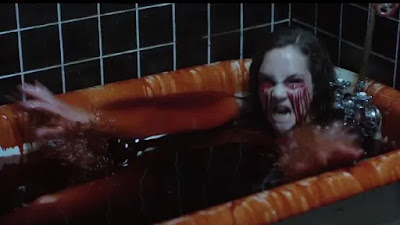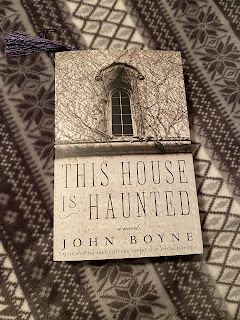So I did a little free trial on YouTube for Shudder, and as I was browsing the titles they had available I saw a film titled Skinamarink. I thought the premise sounded really interesting, I wanted to watch it as soon as I read the simple description of, “Two children wake up in the middle of the night to find their father is missing, and all the windows and doors in their home have vanished.”
That’s something that would be terribly frightening and strange, especially for a child, who are the main characters of the film.
The film is from 2022 and is directed by Kyle Edward Ball–his first feature film. It takes place in 1995, within a house that is inhabited by two children and possibly their parents, who seem to go suddenly missing, and they aren’t the only thing to go missing.
Things in the house start vanishing and the physics and logistics of the house and its objects begin to go topsy-turvy. Any details besides this are vague from the beginning of the film and, perhaps, for the remainder…
The rest of my review will encompass the film as a whole, so if you want to go in spoiler-free, stop reading now and go check it out for yourself!
The movie is stylized with a very dark, vignetted exposure and a very heavy VHS filter overlay. The VHS quality mimicry might make sense if this were a found footage film, but it isn’t found footage, so why the grainy filter? This types of filter has become exceedingly popular in media, to the point where it has crossed the line into trendy. It’s meant to invoke nostalgia and create a sense that what you are watching comes from a VHS camera, as is authentic to the time period in which the narrative takes place. You know how you can achieve the most authentic VHS film quality? You could just shoot your movie on film!Of course, just putting a filter on is more accessible to those on a budget and without having to gather the resources to shoot and edit on tape. I, too, prefer a little more grit and a little less of the overly polished, high production filters on a film, but this is a bit much. The filter is WAY too heavy and exaggerated.Additionally, there are LOTS of still shots, and very few wide shots–most are close-ups. The whole time you are either looking at either the ceiling, the floor, a wall, or a sliver of a hallway or stairway, or just grainy darkness. Characters are not really shown on screen, at least not directly and never a full-body shot. There’s very little dialogue and what does exist is in hushed voices and short sentences. There’s no score; all sound effects are ambient, occurring in the background.
I see what they are going for; it’s definitely an abstract style they’ve opted for, and perhaps they did so with the intention of making their audience work for the story without showing it head-on. For me, I think it would have worked as a short film, but for an entire movie, I need a bit more.
Everything was very minimalist–the shots, the dialogue, the sound effects–and for me it was just too much so and I, personally, found it a bit annoying.
I’m not saying a fim has to be a certain way, that movies have to follow rules and conventions. I appreciate the approach they took and I can see the creativity that came from the mind of the filmmaker. Do I need to see the eyes of the character to know that they are looking at something? No, I can glean that from just seeing their feet; but would I like to see the eyes, torso, arms and head of a character occasionally? Yes, I would. I’m not saying characters need to have drawn out monologues, but I did desire a bit more than one word whispers. To me, it just felt like the movie was composed entirely of b-roll, I needed a little more a-roll to be engaged.
I was drawn in the by uncanny concept of the film, of the doors and windows vanishing but I found that it didn’t really expand much beyond the initial vagueness that intrigued me. I was hoping it would start vague and build into a bigger story, but it was generally the same tone throughout, kind of a steady (if not flat) heart rate, with maybe one or two spikes of tension and excitement, some attributed to a jumpscare triggered by an abrupt loud noise.Maybe I’m being a bit grumpy and nitpicky and being too harsh on Skinamarink. I’m sure not everyone will feel this way about this film; in fact, I’m sure it could potentially cater to a whole audience and a particular generation because of its film style.
It’s not lost on me that Skinmarink is definitely trying to evoke the look, feel, and tone (both visually and narratively) of popular short films and videos on YouTube such as “The Backrooms” and the “Mandela Catalogue”. If you aren’t familiar with these videos, they fall into a relatively new subgenre called analog horror, which is a found footage offshoot that “is commonly characterized by low-fidelity graphics, cryptic messages, and visual styles reminiscent of late 20th-century television and analog recordings.” (“Analog horror”, Wikipedia).This has become the chosen and established style of horror for Gen Z, and in the examples I listed previously, it works very well–I’m particularly a big fan of the Backrooms video series. However, both of those examples are relatively short. Not as short form as a bite-sized TikTok, and nowhere near as long as an actual film, more around fifteen minutes or less.
So, simply because this film is done in the analog horror style (minus the found footage), it could prove to be very creepy, effective, and even inspirational for fans of this genre.
Besides stylistically, this film aIso employs themes recurrent in analog horror and another concept that is very popular recently, known as liminal spaces. The imagery associated with liminal spaces is heavily employed in Skinamarink–there are many shots of doorways, hallways, and stairways. And, of course, the premise of the movie involves the doors and windows. In the current wave of liminal spaces and liminal horror, the passage from childhood to adulthood is heavily focused on, and, in particular, being stuck in the space between the stages of life and the preservation of the comfort and nostalgia of youth. The film stars two children and there are many visuals of toys splayed about the ground; legos, teddy bears, old Fisher Price telephones. The tv is constantly playing old cartoons, and their tinny soundtrack can be heard reverberating softly in the background. The title of the movie is a reference to an old preschool sing-a-long song, so there are many visual and audio themes of childhood. The disappearance of the doors and windows in the house, trapping the children inside, could symbolize their inability or unwillingness to pass through into adulthood.I made a video on my YouTube channel where I go into the origins and explanation of liminal space and examine this current trend. If you are interested, check it out here: https://youtu.be/Xy_DbH7liw8
Like I said, I am a fan of analog horror and liminal space media and the inspirational sources that I believe this film draws from. However, I think if you are unfamiliar with the source media, Skinamarink might not be your best foray into the subgenre.I recommend checking out some other ones first and then if you find you really enjoy it, then check out this movie and see how it falls in with the others.
I do look forward to seeing what director Kyle Edward Ball has next, as I can tell he has a lot of creativity and a clear vision for his projects. So, whether his next project is a feature or short film, I’ll be keeping an eye out to see what he has in store in the future.
~~Marie
















































